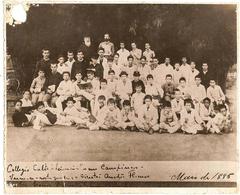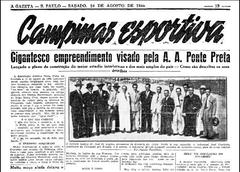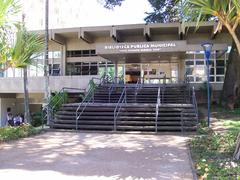
Edifício Itatiaia: Visiting Hours, Tickets, and Guide to Campinas Historical Sites
Date: 03/07/2025
Introduction
Edifício Itatiaia, situated in the heart of Campinas, São Paulo, is an iconic example of Brazilian modernist architecture and stands as Oscar Niemeyer’s only completed building in the city. Conceived and constructed during the 1950s, its innovative design—marked by hallmark elements such as pilotis, brise-soleil, and free façades—symbolizes Campinas’ transformation into a modern urban center. Today, the building is not only architecturally significant but also a vital component of the city’s cultural fabric, having fostered community living and hosted a variety of cultural events throughout its history (Instituto Oscar Niemeyer, IAB Campinas, ArchDaily).
While Edifício Itatiaia is primarily a residential building, its communal areas occasionally open to the public during cultural festivals and special guided tours. Its prime location at Avenida Francisco Glicério and Rua Irmã Serafina, facing Praça Carlos Gomes, makes it easily accessible and an ideal starting point for exploring other Campinas historical sites.
This guide provides a comprehensive overview of Edifício Itatiaia’s history, architectural features, cultural significance, visitor information, and travel tips for making the most of your visit to this modernist landmark.
Table of Contents
- Origins and Architectural Context
- Niemeyer’s Vision and Design Features
- Historical and Cultural Significance
- Preservation and Recognition
- Social and Cultural Impact
- Notable Events and Residents
- Evolution and Adaptation
- Legacy in Brazilian Modernism
- Visiting Edifício Itatiaia: Practical Information
- Nearby Attractions
- Frequently Asked Questions (FAQ)
- Further Reading and References
Origins and Architectural Context
Edifício Itatiaia was designed in 1952 and completed in 1957, representing the city’s embrace of post-war modernist trends. Its name, meaning “rocky cliff” in Tupi-Guarani, pays homage to Brazil’s indigenous heritage and reflects the building’s bold presence. At 19 stories and approximately 60 meters tall, it was among Campinas’ tallest residential structures upon completion (Campinas Memories). The project was commissioned by Ralpho Fonseca Ribeiro and Ruy Hellmeister Novaes and executed by structural engineers Werner Müller and Yasuo Yamamoto (IAB Campinas PDF).
Niemeyer’s Vision and Design Features
Niemeyer’s approach blended technical innovation with social ideals. Key features include:
- V-Shaped Pilotis: Elevate the ground floor, creating open communal space and a welcoming forecourt.
- Brise-Soleil: Sun-shading devices provide both functional protection and visual rhythm across the façades.
- Free Façade and Extensive Windows: Large horizontal windows maximize light and ventilation, characteristic of modernism.
- Undulating Rear Structure: Niemeyer’s signature curves are visible from Rua Coronel Rodovalho.
- Communal Amenities: Rooftop terrace, laundry, and garden areas foster a sense of community.
The absence of a subsoil level and the use of reinforced concrete waffle slabs allowed for open-plan interiors and innovative structural solutions (IAB Campinas).
Historical and Cultural Significance
Edifício Itatiaia marked a turning point in Campinas’ urban development, symbolizing progress and modernity during a period of rapid transformation from an agricultural to an urban economy (Prefeitura de Campinas). Its central location along Avenida Francisco Glicério integrated it into the city’s commercial and cultural life, and its reputation as a home for academics, artists, and professionals further established its influence on local society.
Preservation and Recognition
Although not officially listed as a national heritage site, Edifício Itatiaia has been protected as a cultural asset since 2011 and is frequently cited in academic studies as a benchmark of Brazilian mid-century modernism (IPHAN, Vitruvius). Restoration initiatives have preserved key features such as the façade, communal areas, and original finishes, ensuring its continued prominence.
Social and Cultural Impact
Edifício Itatiaia’s communal spaces have long served as venues for art exhibitions, literary readings, and community gatherings, enriching Campinas’ cultural landscape (Campinas Cultura). Its influence extends to the surrounding neighborhoods, inspiring further modernist development and contributing to the area’s revitalization.
Notable Events and Residents
While specific residents are not publicly named for privacy reasons, the building has attracted prominent cultural and academic figures. During the annual Virada Cultural festival, Edifício Itatiaia’s communal spaces have hosted public art installations and performances, reinforcing its reputation as a cultural hub (Virada Cultural Campinas).
Evolution and Adaptation
Modern updates have included elevator upgrades, security enhancements, and improved accessibility, including ramps and elevators for visitors with limited mobility. Sustainability initiatives such as energy-efficient lighting and recycling programs reflect contemporary concerns without compromising the building’s historical character (Campinas Urbanismo).
Legacy in Brazilian Modernism
As one of Oscar Niemeyer’s rare residential projects outside Brazil’s major metropolises, Edifício Itatiaia serves as a case study in the integration of form, function, and community. Its enduring influence is evident in the continued interest from architects, urban planners, and cultural historians (Instituto Oscar Niemeyer).
Visiting Edifício Itatiaia: Practical Information
Address: Rua Irmã Serafina, facing Praça Carlos Gomes, Campinas, SP
Visiting Hours
- Exterior: Accessible at any time during daylight hours.
- Interior/Common Areas: Open to the public only during special events or guided tours, typically on weekdays (Mon–Fri, 9:00 AM–5:00 PM) or by appointment.
Tickets and Entry
- No tickets required for viewing the exterior.
- Guided tours may be available during cultural festivals or by arrangement with local heritage offices; some may charge a fee.
Accessibility
- The building and surrounding sidewalks are largely accessible.
- Elevators and ramps serve residents and authorized visitors; some areas may have limited accessibility due to the building’s age.
How to Get There
- Public Transportation: The central bus terminal is less than 1 km away, and several lines stop nearby.
- By Car: Paid street parking and private lots are available, though limited during events.
- On Foot: The building is a short walk from major downtown attractions.
Nearby Attractions
- Praça Carlos Gomes: A tranquil square ideal for relaxation and photography.
- Museu da Imagem e do Som: Showcasing exhibits on photography and sound.
- Mercado Municipal de Campinas: A bustling market for local foods and crafts.
- Centro de Convivência Cultural de Campinas: Offers theater, music, and cultural events.
- Cafés and Restaurants: Numerous options are available in the surrounding Centro and Cambuí neighborhoods.
Frequently Asked Questions (FAQ)
Q: Can I visit the interior of Edifício Itatiaia?
A: General public access is only allowed during guided tours or cultural events; otherwise, entry is restricted.
Q: Is there an entry fee?
A: No fee is required for exterior viewing; some guided tours may charge.
Q: Is the building wheelchair accessible?
A: Many areas are accessible, but some limitations exist due to the building’s age and layout.
Q: When are the best times to visit?
A: Mornings and late afternoons offer optimal lighting for photography; check event calendars for interior access opportunities.
Practical Tips for Visitors
- Photography: Best angles from Praça Carlos Gomes; respect residents’ privacy.
- Safety: Area is safe during the day; avoid late evening visits.
- Etiquette: Remain in public areas, keep noise low, and do not disturb residents.
Preservation and Regulations
Respect preservation guidelines by not marking or entering restricted areas. Commercial photography or activities require prior authorization.
Summary and Recommendations
Edifício Itatiaia is both a monument to Brazilian modernism and a living part of Campinas’ cultural identity. While interior access is limited, its architectural grandeur can be fully appreciated from public spaces. Pair your visit with other historical sites in the city center for a richer experience. For updates on tours and cultural events, consult local tourism offices or download the Audiala app for interactive guides and exclusive content.
Further Reading and References
- Instituto Oscar Niemeyer
- IAB Campinas
- IAB Campinas PDF
- ArchDaily
- FAU Unicamp
- Campinas Memories
- Prefeitura de Campinas
- Campinas Cultura
- Virada Cultural Campinas
- IPHAN
- Vitruvius
- Campinas Urbanismo
- Visit Campinas
- CBN Campinas






